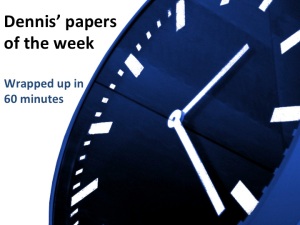 Back from Israel. This week I will send you on holidays with a lot of interesting papers for the the time off. Hopefully you will find time to read some of these papers and won’t get overwhelmed by the amount of studies this week. Here we go:
Back from Israel. This week I will send you on holidays with a lot of interesting papers for the the time off. Hopefully you will find time to read some of these papers and won’t get overwhelmed by the amount of studies this week. Here we go:
Author Archives: dennislal
Papers of the week (w49)
 Christmas parties, grant deadlines, paper revising and preparation for the upcoming Young Researchers in Epileptology Meeting in Sde Boker, Israel next week. As always, the first weeks in December are intense but the right time to think about your research and plan the next year. Continue reading
Christmas parties, grant deadlines, paper revising and preparation for the upcoming Young Researchers in Epileptology Meeting in Sde Boker, Israel next week. As always, the first weeks in December are intense but the right time to think about your research and plan the next year. Continue reading
Papers of the week – Copy Number Variations
 Variations on Copy Numbers. In the third issue of our series on the papers of the week I will focus on the detection and annotation of the most common form of structural variation encountered in genomes. Deletions, duplications and inversions are frequent events, which are surprisingly hard to deal with using sequencing-based tools. Hence, this is an area of active development.
Variations on Copy Numbers. In the third issue of our series on the papers of the week I will focus on the detection and annotation of the most common form of structural variation encountered in genomes. Deletions, duplications and inversions are frequent events, which are surprisingly hard to deal with using sequencing-based tools. Hence, this is an area of active development.
The human genome is way too complicated for me
What has become of that simple 21,000-gene genome of ours? Today even the definition of gene is no longer clear. What biotypes belong to lncRNAs and what’s the job of unitary pseudogenes? For geneticists dog-paddling in complex diseases another surprise came last year with the announcement that roughly 80% of the genome has some sort of function. Confused? Grab this issue of Genome Research and read the review by Mudge and colleagues, who discuss many examples of the transcriptional complexity within the human genome. Continue reading
Papers of the week (w47)
 Thursday again already? Well, after the positive feedback from colleagues and friends I must continue. I like ambitious goals and hope that the epilepsy genetics community finds this new series on papers of the week helpful. Let’s start with a Science paper by McConnell and collaborators on somatic copy number variations in neurons, a paper that was also mentioned in a recent post. I wanted to know more about the single cell sequencing methodology. Continue reading
Thursday again already? Well, after the positive feedback from colleagues and friends I must continue. I like ambitious goals and hope that the epilepsy genetics community finds this new series on papers of the week helpful. Let’s start with a Science paper by McConnell and collaborators on somatic copy number variations in neurons, a paper that was also mentioned in a recent post. I wanted to know more about the single cell sequencing methodology. Continue reading
Papers of the week

My name is Dennis Lal, I am working on the genetics of rolandic epilepsy and idiopathic generalized epilepsies within the EuroEPINOMICS consortium. Like many scientists, I read a lot of publications, or well, at least the abstract. Roland and Ingo asked me repeatedly to write a post but I was afraid of losing too much time. But as a young and naive scientist you have to give things a try.That’s why I started commenting on my favorite papers of the week, collected here. This “experiment” is currently at 35 minutes (after several rounds of editing) and I aim to finish this blog post below 60 minutes.

